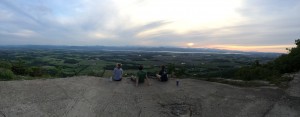“Tradition, tradition! Tradition!
Tradition, tradition! Tradition!” ~ Tevye, Fiddler on the Roof

After several millennia of civilized life, the world still lacks a good definition of “human.” The interwoven classes of subject matter commonly labeled “humanities” makes some attempt to help us better understand this word. Study of culture, literature, history, or the arts inevitably deepens our understanding of our own “humanity” and grants us an expanded perspective on both the idiosyncrasies and generalities of the human experience. Even amidst the rapidly proliferating collegiate programs aimed towards vocational and technical training, a rich exposure to the humanities remains a central goal of the liberal arts — an educational model of which Middlebury College functions as exemplar. Here we study not just what constitutes humanity but also what it means to be a human. This inquiry runs deep and takes far longer than four years to properly answer, but one facet of such a complex answer evinces itself relatively quickly in one’s time at Middlebury: tradition thrives here, and for good purpose.
Few experiences aptly mark the uniqueness of a Middlebury education like the hallowed hike up Snake Mountain. For some, the hike becomes as ubiquitous as writing a paper or reading a book. For others, the journey only occurs once in their four years here — a fleeting blip on their collegiate radar. For everyone, the trek leaves an indelible mark upon the soul.
The drive there from campus takes less of one’s life than the time necessary to watch a short television show, but the journey presents marvelous splendor unmeasurable in either metric or imperial systems, land touched by the hand of some divine force. You pass rolling hills and fertile farmland. As you travel, your context leaves you in the fiery calm mindset of a dedicated wayfarer. Then, all of a sudden yet exactly when it felt right, you find yourself there.
A small unpaved parking lot marks the point of entry from the bottom of the valley unto the trail. From here, you begin. In a moment’s time you find yourself transported from the semi-developed farmland of the Champlain Valley to a dense maple forest. You can’t help but notice a fundamental change in the ethos of the air that surrounds you. The trail pulses and overflows with life and splendor as your feet carry you higher and higher up the mountain, through the moments. Something about the journey upward, further and faster, unleashes primal sentiment from deep within the trenches of your soul. Your subconscious screams with joy, recognizing this place as timeless. Your fathers, and their fathers born many a year before them, traversed this mountain. Every moment crushes you with the weight of all the Earth’s gravity while concurrently releasing you as you feel your own lightness increase with each step. “Just a few steps further,” you lie to yourself. You push yourself forward like a tank on the battlefield, like the politician on election day, like the lioness inches away from the kill, like the cold and brutal winter on the verge of giving way to the sweetest spring, like the list that goes on far longer than it should have. You press on.
Then, you’re there. You stop and breathe it in. The sublime splendor of omnipresence. The world opens up before you. Lake Champlain might as well be the edge of the universe, and you’ve conquered it. Here we learn the precious lesson: you have to feel small to get the big picture.
Before you know it, it’s time to head down the mountain. You venture back to your car, back to your responsibilities, back to the vagaries of modern life. But, in a certain sense, the mountain never leaves you. That’s the whole point of tradition.